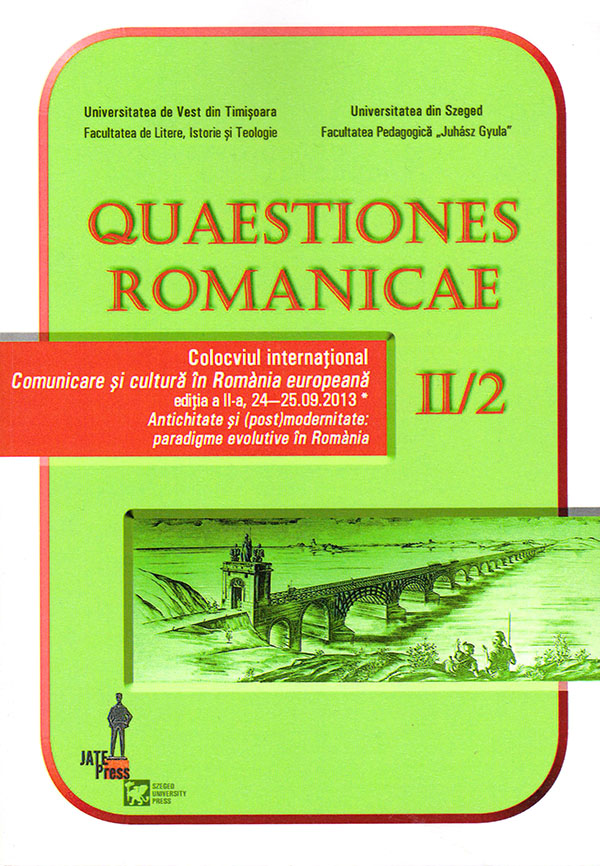Retorică şi comunicare în spaţiul cultural românesc din secolul al XIX-lea
Abstract: (Rhetoric and Communication in the Romanian Culture from the Nineteenth Century) The 19th century of the Romanian culture is dominated by rhetoric, not only in its textual, erudite expression, but also in its theoretical forms. The theoretical texts published in this period show a strong wish of the Romanian scholars to apply classical models in writings and in the Romanian language practice. The possibilities of the Romanian language in the 19th century being limited, the role of the rhetoric authors was huge for the development of themodern literary Romanian language, their effort for building an aesthetic language being evident in the literary practice of the treaties. Thus, the Romanian literary language and literature was led to its self-consciousness affirmation, proving with valuable arguments the possibilities of the Romanian language in the 19th century. The enlightenment ideas (patriotism, "progress", "enlightenment" under the influence of the creative personalities, improvement of language based on the social progress etc.) have led to the renaissance of the Romanian culture. On the way opened by the rhetorical intertextuality (uninterrupted in the Romanian culture regardless of epochs), some authors of that time recommended as a "duty" of the creators to follow the rules imposed by the “classical” style, which governs the Romanian poetics for the time being. However, in the second half of the 19th century, the poetic expression improves and, even though it still uses the conventional expression, it becomes more natural on its way to the modern and mature poetics from the end of the 19th century.
Keywords: paradigmatic vision, model, rule, canon, imitation, mimesis, prépon, harmony, elocutio, ornatus, patriotism, “enlightenment”, taste, mimetic vision, poetic vision, poetic revolution, modern vision.
Rezumat: În spaţiul românesc al culturii majore, secolul al XIX-lea este dominat de retorică, în manifestarea ei textuală, savantă, erudită, dar şi în manifestări teoretice. Textele teoretice publicate în această perioadă dovedesc puternica dorinţă a cărturarilor români de a oferi scrisului şi practicii limbii române modele stilistice clasice, a căror atemporalitate să asigure îndepărtarea conştientă de uzul cotidian al limbii literare, de uzul popular. Dorinţa de „universalitate” a limbii se manifestă consecvent sub semnul conştiinţei artistice de tip clasicist. Posibilităţile limbii române din secolul al XIXlea fiind limitate, rolul autorilor de retorici a fost uriaş în procesul dezvoltării limbii române literare, întrucât prin efortul lor de estetizare a limbii, prin travaliul pe care l-au realizat în cadrul practicii literare din tratatele lor, au reuşit să „îndrepte” limba literară şi literatura română spre afirmarea conştiinţei de sine. Principiile fundamentale ale Iluminismului au declanşat şi au susţinut procesul de „cultivare” a limbii române, idei importante ale acestui curent (patriotism, „geniu” al limbii, „progres” şi „luminare” a maselor sub influenţa personalităţilor creatoare, perfecţionare a limbii odată cu progresul social etc.) conducând la regenerarea culturii române. Continuatori ai unei intertextualităţi retorice (neîntrerupte în cultura română indiferent de epocă), unii autori au recomandat ca o „datorie” a creatorilor „păzirea” regulilor, legi de netrecut ale stilisticii clasice, ce dau sens, deocamdată, mişcării „poetice” româneşti. În a doua jumătate a secolului al XIX-lea, expresia poetică se şlefuieşte şi, deşi încă tributară exprimării convenţionale, devine mai naturală, evoluând spre poetica modernă, autonomă şi matură, de la sfârşitul secolului al XIX-lea.
Cuvinte-cheie: viziune paradigmatică, model, normă, canon, imitaţie, mimesis, prépon, armonie, elocutio, ornatus, patriotism, „luminare”, gust, viziune mimetică, „poetică a viziunii”, „revoluţie poetică”, viziune modernă.
